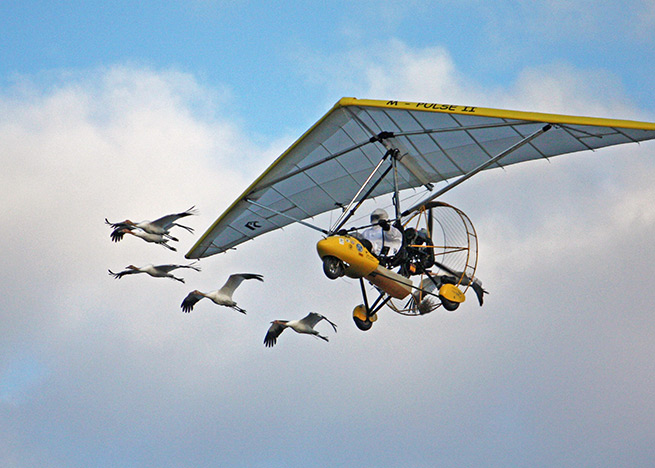
An FAA-mandated aircraft upgrade promises to be pricey, taxing the resources of a decade-old organization dedicated to restoration of the endangered whooping crane.
Operation Migration was founded in 2001 to lead captive-bred birds on annual journeys from Wisconsin to Florida, working with a coalition of government and nonprofit groups seeking to restore a species that was driven to the brink of extinction by the 1940s.
Co-founder Joseph Duff leads a small and dedicated cadre of aviators who pilot weight-shift-control aircraft in formation with the birds, teaching them ancestral routes between seasonal nesting grounds. Great care is taken to avoid exposing the birds to human contact: Pilots wear costumes and use puppets to interact with the birds, and the journey is both time-consuming and rewarding, Duff said.
All was going well until a complaint prompted an FAA investigation that grounded the operation in 2012, thanks to pilot and aircraft certification issues. The FAA granted a temporary exemption (though not in time to complete the 2012 journey, which ended in Alabama rather than Florida) giving Duff and his organization two years to obtain special light sport aircraft (SLSA) to replace the experimental models used for years, and secure private pilot certificates for all three participating pilots. The nonprofit has turned to crowdsourcing to raise $84,700 to cover the cost of replacing the tiny squadron, and $26,350 had been raised by June 12, with 45 days to go. Duff said the new aircraft will be customized by North Wing, producer of various ultralight models, to meet the particular demands of the FAA and the mission. While a whooping crane can cruise at 38 mph, leading them often requires the aircraft to slow to 33 mph to allow the birds to catch up, just above the 32 mph stall speed.
“That’s something you can’t do with a stick-and-rudder aircraft,” Duff said. The control bar allows pilots to precisely control the wing shape, and the airflow separation boundary.
“You can actually do that one-handed while you’re turned around watching the birds,” Duff said, noting that the pilot can feel passing air with exquisite sensitivity. “In fact, when the birds get ahead of us and they’re flapping their wings ahead of us, you can feel that pulse in the wing.”
While the FAA relented on requiring commercial pilot certificates for these aviators, who devote much of the year to the mission, there will be work ahead customizing a North Wing SLSA model with a smaller engine and other modifications. Duff said North Wing, in addition to offering a discount, has also agreed to handle the paperwork and certification process.
The whooping cranes are born to a captive flock housed at the Patuxent Wildlife Research Center in Maryland, where the training begins with puppets and the aircraft, giving the birds a chance to acclimate to their “leader.” The class of 2013 will soon be ready to fly to Wisconsin, where the birds will spend the summer before launching the 1,200-mile journey to the winter grounds in Florida.
“If we’re lucky, we finish by December,” Duff said. Though he is always on the lookout for pilots willing to participate, it is a tall order. A full season of training is required to develop the skills for both handling the aircraft and working with the birds, who must sometimes be coaxed along the way. Pilots must be adept at precise control of speed and climb rate, and weight-shift-control aircraft are very different from conventional airplanes: Everything is backward. To climb, a pilot must push the control bar forward, for example, and the reverse is also true. Add to that the months away from home required by the job, and it becomes one with relatively narrow appeal.
The fruits of the labor so far have been impressive: More than 100 birds are now flying the Eastern migration route (another population commutes between Texas and Canada), though more breeding pairs are needed before the Eastern population can sustain itself.



